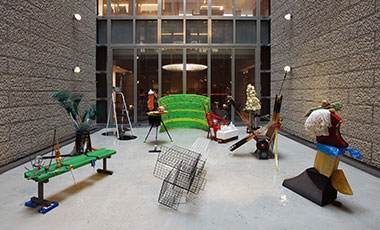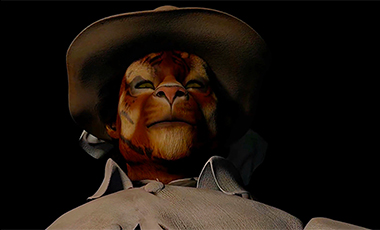In the NovemberArt Talk, we review the 《Deoksugung Project》 (2012.9.19.~12.2, Deoksugung Palace), which has brought a nation-wide sensation through the encounter between Deoksugung and Korean contemporary art. At every place in Deoksugung which has various time layers as a historical site, this art project exhibits various works of Korean contemporary art by diverse creators from diverse fields such as artists, dancers, and so on. As far as the Art Talk is a comer that proposes diverse points of view through cross-criticisms by diverse experts from various fields, we reviewed this project and art works this time with peculiar aspects of diverse critics of various fields, including the curator of the project.
《Deoksugung Project》: The inside of time in the eternal rest
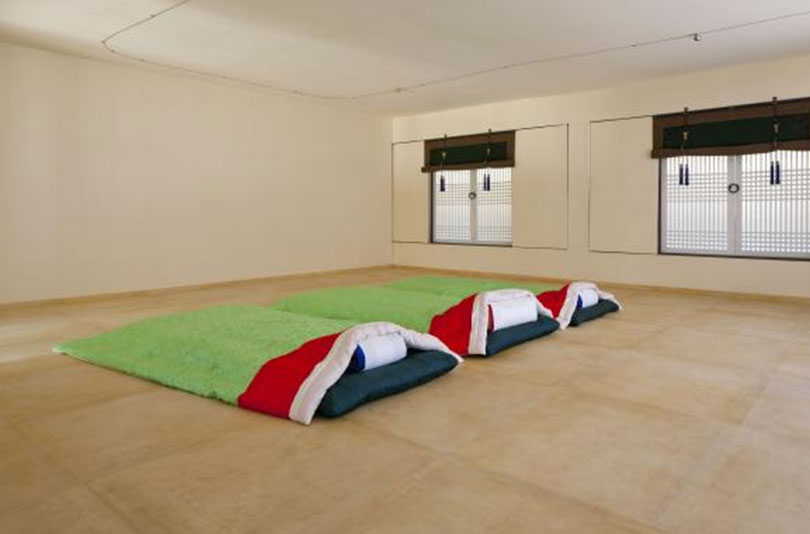 Do Ho Suh_Hamnyeongjeon, Hamnyeongjeon project-East Ondol Room, National Museum of Contemporary Art Korea, Commission, 2012 (Performer: Jung Youngdoo)
Do Ho Suh_Hamnyeongjeon, Hamnyeongjeon project-East Ondol Room, National Museum of Contemporary Art Korea, Commission, 2012 (Performer: Jung Youngdoo)
There is the sound of time from the cold floors and the creaking windows of Hamnyeongjeon. Passing Jasi(the 1st of the 24 periods of the day by old Korean time division, from 11:30pm to 1:30 am), Chuksi(1:30-3:30am) through Yusi, Sulsi Haesi...... the dead time of the empty palace, once again, moves toward its eternity. The sound of time elapses for the only one person to lay himself on the three Boryo(a traditional fancy bedding mattress). He is the living and the dead man at the place where he sleeps, neatly prepared by two women. Emperor Gojong who met his demise while staying in Hamnyeongjeon abruptly enters into its time and dreams of an apprehensive dream. With his life being divided into three parts on the three Boryo, himself is not able to rest in peace but only wanders in his awake. His mumbling in between the father and the wife, the closed-door and the open-minded, the powers and the empire, and the people and the reign sounds like the moaning of the Korean Empire in such agony. Both the dazzlingly bright room and the unfortunate history survive in pain that way. The palace embraces the people who once governed the country and the collapse of history at the same time. The splendor of the biggest palace in the Chosun Dynasty particularly touches as much as the time and the death of its compassion. The birthday of the king was called Hamnyeongjul while the declining year of Gwangmu met its death in Hamnyeongjeon with despair. He was the emperor who relinquished the thrown and the epithet of "Deoksu (Moral Life)" was scarcely kept. Therefore, the carefully prepared Boryo on East ondol room (Korean floor heating system) and the glowing room are like the dedication to the rest of the empire as well as the man who cannot easily close his eyes.
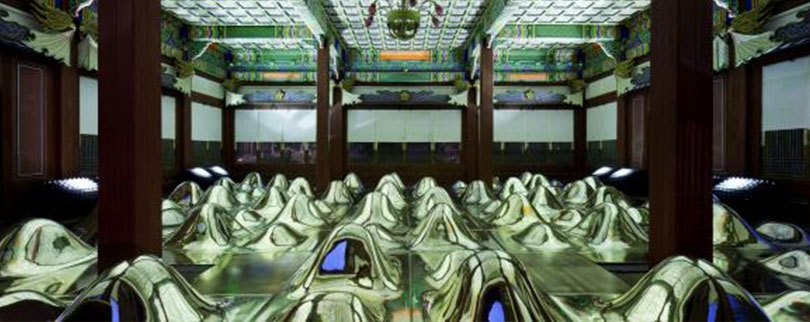 Ha Jihoon_Deokhongjeon, Jari_National Museum of Contemporary Art Korea, Commission, 2012 (Sound: Sung Kiwan)
Ha Jihoon_Deokhongjeon, Jari_National Museum of Contemporary Art Korea, Commission, 2012 (Sound: Sung Kiwan)
The person who can change the court of the palace keeps the power of the nation as collateral. Turning from the space of lamentation into the space of reception. It disproves the collapse of the palace where it was filled with the symbols of the reign and the monarch. Kyounghyojeon, the soul temple for Empress Myongseong until the fire at Deoksugung, was moved and rebuilt as the splendid palace, Deokhongjeon. Ha Jihoon distinctly spotlights the unpleasant glamour which was for to stand to step on one's death, with its bright lighting. A pillar with the decoration of golden phoenix, a crossbeam with flowering plum embedded and a ceiling with multicolored paintwork shines onto the soaring golden chairs in all directions. Sitting in this glitz while losing a sense of reality, "What is this place?" I questioned. And then realize soon this place is upside down. The top became the bottom and the bottom became the top. The golden requiem of the weighed down soul penetrates the floor of where it is supposed to be. Barely connected wave of sound wakes the stiff time up, and enters this upside down world, which makes me stare at time of colony where the sorrow was ornamented with joyfulness. But the 'spot' of its mix of light, music and power comprises the optimism. What it fills the space, the surprisingly lifelike thing is the energy that past delivers toward present.
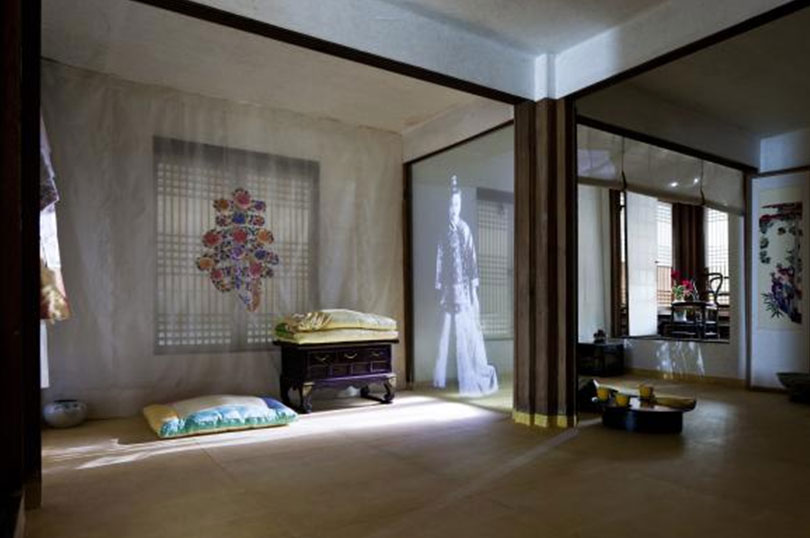 Traditional Korean Costume Kim Young Seok_Seogeodang, Better Days_National Museum of Contemporary Art Korea, Commission, 2012
Traditional Korean Costume Kim Young Seok_Seogeodang, Better Days_National Museum of Contemporary Art Korea, Commission, 2012
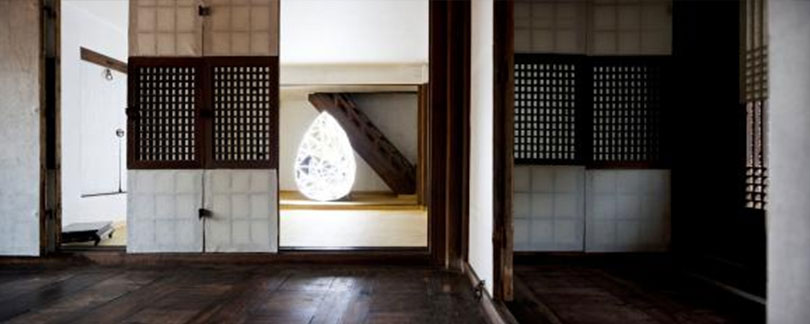 Yeesookyung_Seogeodang, Tear Drop_National Museum of Contemporary Art Korea, Commission, 2012
Yeesookyung_Seogeodang, Tear Drop_National Museum of Contemporary Art Korea, Commission, 2012
There is quiet liveliness in the room of Seogeodang as if the place is left out. The rooms of the history in empty palaces are awake through the ride of the collectibles of Kim Young Seok, and embrace the warmth, then represent on the flow of time. And it reflects onto its thin layer the blissful days of Princess Deokhye who endeared herself to Emperor Gojong. Its black-and-white photographic images are reminiscent of "Death is the essence of the photo," by Roland Barthes and the sorrow of the past days soaks into the antique room. We all know the girl in the picture will become shortly embroiled in such an arduous journey. The room of Seogeodang where she used to stay makes us witness the moment of joys of her long life and those short period of paradise for a moment. The emitting light in the empty house of past time as a huge diamond is a sentiment of sorrow. It is not because of the death image that the irreparable past arouses. It is the lavish and sad tear drop while recorded tears within a history and secret tears of individual tangle up and create together. Seogeodang might have carried a lot of tear drops for a long history as watching the span of Jungreongdong Haenggung, Gyeongungung and Deoksugung through all its time. Yeesookyung created its tear drop with thousands of LED lights. The small tears which thoroughly emit the room reflect on each others and merge into one stronger light. Even though the light shines the last stories of Queen Dowager Inmok who worried about her life from day to day and Princess Deokhye who had ended her miserable life suffering from schizophrenia, a dramatic melancholy within tears of queen and a raging wave of cruel history stand in front of us as different implications of jewellery and tears.
Deoksugung Project viewed by 6 people
I want to go further back in time _ Kim, So-yeon(Theater critic)
《Deoksugung Project》: Contemporary Interpretation on Legacy
《Deoksugung Project》: To get over the Sadness to Pieces
《Deoksugung Project》: Reconciliation between Crash of Time and Scenography
《Deoksugung Project》: The Calling of Memory

GU Nayeon / Art Critic
GU Nayeon studied art theory at Korea National University ofArts. She has written about contemporary art of Korea and Japan. She published her thesis “Gutai Art and Modernism Experience of Post-war Japan” (2007), wrote Drifting Art(Gwacheon: Zininzin, 2018) and translated Tokyo Beta (2016) by KENRO Hayamizu (速水健朗) into Korean.

